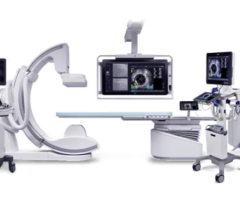May 11, 2012 — A new report issued this week by the American College of Cardiology Foundation (ACCF) and the Society for Cardiovascular Angiography and Interventions (SCAI), in collaboration with a dozen other professional societies, provides detailed criteria to help clinicians determine when cardiac catheterization is a reasonable option for the evaluation of patients for heart disease.
“Invasive coronary catheterization is a cornerstone for how we diagnose and care for people with heart disease,” said Manesh Patel, M.D., the John Bush Simpson assistant professor of cardiology at Duke University and co-chair of the writing group. “We want to encourage the appropriate and judicious use of all of our techniques and procedures. With this document, we aim to help all clinicians – not just cardiologists – determine when it would be reasonable to perform diagnostic cardiac catheterization.”
The panel identified 166 possible clinical scenarios when referral for diagnostic catheterization might be considered – drawn from the medical literature and anticipated clinical applications – and then assessed the appropriateness for each indication. Altogether, the group determined cardiac catheterization to be “appropriate” in about half of the clinical situations evaluated. Nearly 30 percent of the scenarios were rated as “uncertain,” where the procedure may be considered reasonable. The authors stress an uncertain designation should not be used as grounds for denial of reimbursement. Notably, cardiac catheterization was deemed not reasonable or “inappropriate” for 25 percent of the indications rated. Patel adds these are cases for which the procedure is not needed most of the time, but it is expected that a small percentage of the cases may be justified based on extenuating clinical circumstances.
“When the procedure and the incremental information it provides outweighs the risk, it allows us to provide differential care that can help improve a patient’s symptoms, health status and long-term clinical outcomes,” said Patel. “In our ongoing effort to provide efficient, quality cardiovascular care, we hope these criteria will support real-time clinical decisions.”
While the document primarily focuses on the standard use of catheterization to detect blockages in the arteries that are indicative of coronary artery disease (CAD), the writing group also considered its application as part of an arrhythmia workup, in pre-operative testing and to evaluate patients with possible valve disease, pulmonary hypertension or issues with the heart muscles’ squeezing capacity. Although experts want to guard against overuse of cardiac catheterization and spare patients unnecessary procedures, there is also concern about underuse of the test, especially in patients who need more timely diagnosis and for whom a cardiac stress test, for example, might delay a correct diagnosis and add unnecessary costs.
In general, the technical panel advises that cardiac catheterization is appropriate in patients:
- Without prior stress testing but who report symptoms and have a high pretest probability, or high likelihood of disease in the physician’s judgment;
- With definite or suspected acute coronary syndrome; and
- With typical symptoms and intermediate- or high-risk findings on prior diagnostic testing.
The panel noted certain situations in which individuals should not be referred directly to cardiac catheterization. Among others, these include diagnostic workups for:
- Asymptomatic patients at low risk for CAD or without significant symptoms suggestive of heart disease;
- As part of a preoperative work up for non-cardiac surgery in patients with good functional or exercise capacity; and/or
- Those undergoing low-risk surgeries (if a patient has significant risk factors or is undergoing transplantation or heart valve surgery, diagnostic catheterization is warranted).
Patel says because there are many nuances in caring for patients with heart disease, clinical judgment should play a role for individual patients, and there might be other valid reasons to do a catheterization. The writing group and technical panel favor the collaborative interaction between patients, referring clinicians and cardiologists in determining the need for these invasive procedures. As always, careful assessment of patients’ risk and presenting symptoms, as well as results of any stress and other noninvasive tests, should factor into decisions to refer to the cath lab.
This document will be translated into order sheets and decision support tools as part of both ACCF’s and SCAI’s ongoing commitment to improving cardiac care. In addition, the writing group intended that these indications would be linked with the coronary revascularization AUC (appropriate use criteria) to increase the right patients undergoing appropriate invasive catheterization procedures before discussions and considerations around revascularization.
The AUC were developed in collaboration with the American Association for Thoracic Surgery, American Heart Association, American Society of Echocardiography, American Society of Nuclear Cardiology, Heart Failure Society of America, Heart Rhythm Society, Society of Critical Care Medicine, Society of Cardiovascular Computed Tomography, Society for Cardiovascular Magnetic Resonance and the Society of Thoracic Surgeons.
Flow diagrams and a referral sheet for diagnostic catheterization are included with the report. Full text of the report will be published in the May 29, 2012, issue of the Journal of the American College of Cardiology and on the ACC website (www.cardiosource.org). It will also be co-published in Catheterization and Cardiovascular Interventions and the Journal of Thoracic and Cardiovascular Surgery.


 December 20, 2023
December 20, 2023 








